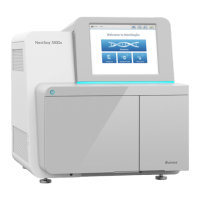Chapter 3 Sequencing
Introduction 15
Sequencing Workflow 16
Prepare the Reagent Cartridge 16
Prepare the Flow Cell 17
Prepare Libraries for Sequencing 17
Set Up a Sequencing Run 18
Monitor Run Progress 24
Automatic Post-Run Wash 26
Introduction
To perform a sequencing run on the NextSeq 550Dx instrument, prepare a reagent cartridge and flow
cell, and then follow the software prompts to set up and start the run. Cluster generation and sequencing
are performed on-instrument. After the run, an instrument wash begins automatically using components
already loaded on the instrument.
Cluster Generation
During cluster generation, single DNA molecules are bound to the surface of the flow cell, and then
amplified to form clusters.
Sequencing
Clusters are imaged using two-channel sequencing chemistry and filter combinations specific to each of
the fluorescently labeled nucleotides. After imaging of a tile on the flow cell is complete, the next tile is
imaged. The process is repeated for each cycle of sequencing. Following image analysis, the software
performs base calling, filtering, and quality scoring.
Monitor run progress and statistics from the control software interface, from the Run tab on BaseSpace,
or from a networked computer using the Sequencing Analysis Viewer (SAV) software. See
Sequencing
Analysis Viewer
on page 26.
Analysis
As the run progresses, the control software automatically transfers base call (BCL) files to BaseSpace
or the specified output location for secondary analysis.
Several analysis methods are available depending on your application. For more information, see the
BaseSpace help (help.basespace.illumina.com)
.
Sequencing Run Duration
Sequencing run duration depends on the number of cycles performed. The maximum run length is a
paired-end run of 150 cycles each read (2 x 150), plus up to 8 cycles each for 2 index reads.
Number of Cycles in a Read
In a sequencing run, the number of cycles performed in a read is 1 more cycle than the number of
cycles analyzed. For example, a paired-end 150-cycle run performs reads of 151-cycles (2 × 151) for a
total of 302 cycles. At the end of the run, 2 x 150 cycles are analyzed. The extra cycle is required for
phasing and prephasing calculations.
Document # 1000000041922 v01
For Research Use Only. Not for use in diagnostic procedures.
15

